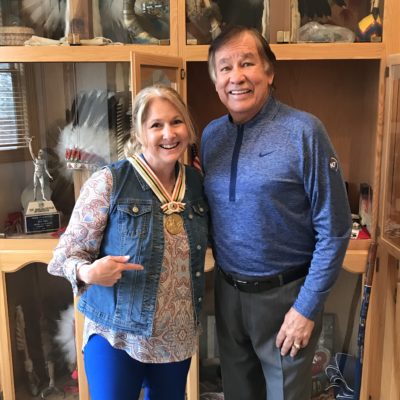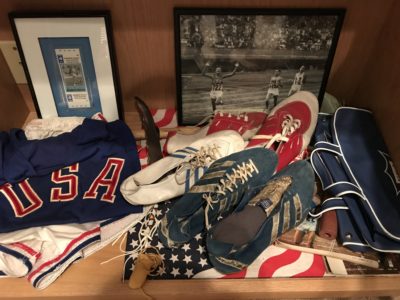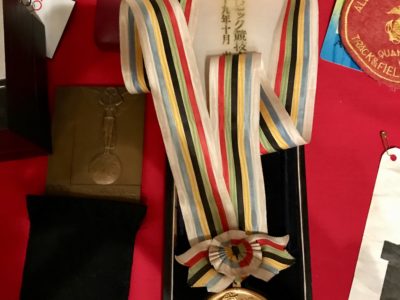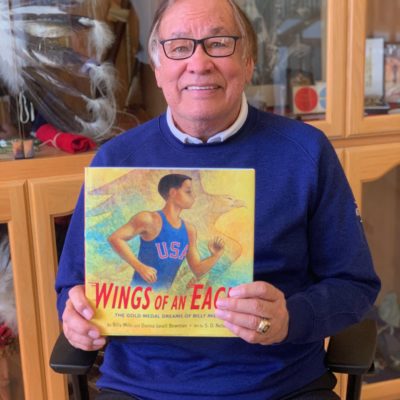As the July 2024 publication nears for WINGS OF AN EAGLE: THE GOLD MEDAL DREAMS OF BILLY MILLS, co-authored with Billy Mills and illustrated by S.D. Nelson, it seems fitting to share the story behind the story:

Donna and Billy. January 2020
Where did the idea come from for WINGS OF AN EAGLE?
In 2014-2015, while researching The Lakota, Dakota, and Nakota (often referred to collectively as the Sioux) for a different project, I learned about Billy Mills (Oglala Lakota) for the first time. A hero to Indigenous people around the world, especially in the United States, Billy’s early life had been full of hardship, poverty, and the loss of both parents. Then came lifelong health challenges and systemic racism that could have crippled him. He overcame these obstacles by running toward an Olympic dream. After earning his gold medal, he used his achievement to lift others through a life of service. His was the ultimate underdog story, and I was awed. At some point, I realized that Billy was the subject of the 1980s movie, Running Brave. Why weren’t there books about him? It’s worth noting that, as of today, Billy is still the only American athlete to win gold in the 10,000-meter event and one of only two Native Americans to win gold in ANY track & field event. Jim Thorpe was the first in 1912.
At first, simple curiosity compelled me to dive into research about Billy. I filled an enormous binder with newspaper articles about his athletic involvement and achievements dating back to 1955, when Billy was in high school at the Haskell Institute residential school. In addition to newspaper coverage and family data, I gathered U.S. census records; Indian census records; six decades worth of print, audio, and video interviews with Billy; and witness accounts. I read, watched, and listened to Lakota history and Native oral histories, all of which dispelled the myths and lies in the history books from my youth. When I began my first semester as an MFA student at Vermont College of Fine Arts in 2015, Billy’s story wouldn’t let go of me. In November of 2015, I wrote the first draft of a picture book about him as part of my creative packet work. That’s all it was supposed to be at first, but when it hit the page, I knew it had potential. My literary agent agreed, but we both knew that, though I had the First Amendment right to write anything, it would not be appropriate for me, a white woman, to publish a story about Billy unless I had his blessings and input. Native stories and symbols have been appropriated for too long!
The long road to connecting with Billy
At the time, the most I hoped for was an interview with Billy and a chance to discuss my book idea. But Billy was in almost constant travel mode, speaking around the world about the complex subject of Native American history, generational poverty and trauma, and the critical importance of unity through diversity. I scrolled the web for any phone numbers and email addresses I could find and sent my first nervous message through a speaker’s bureau in late 2016. Nobody responded. I emailed and called his nonprofit, trying to get a message to him. Still no response. I widened my search, even turning to social media direct messages. I won’t bore you with the tedium of my lonnnnng, persistent outreach. There were sporadic positive responses from Billy’s team, but their was no room in Billy’s schedule for an interview. Then, finally, in December 2019—49 months and 43 messages after my 2015 first draft — I was told that Billy had TWO DAYS available in January 2020. I immediately booked flights.
By the time my college athlete son and I arrived at the Mills’ home, I was a bundle of nerves. After all these years, I would finally meet the man who had inspired my dogged pursuit. Pat Mills met us at the door with, what I now know to be her trademark warmth. We immediately felt at ease. There were hugs and smiles, as if we had known each other for years. For the entire day, Billy shared his life story with me—far beyond the scope of my picture book manuscript. He was so generous, I barely glanced at my pages of questions. Mostly, I listened.
At one point, Billy led us to his “cabinet of curiosities” to see the memorabilia from his athletic and Olympic career. There were the running shoes he wore during his Olympic win, minus one shoelace that one of his daughters used for a craft project decades earlier. There were photos of him with Jesse Owens, Mohammed Ali, and other sports icons, and an Olympic torch from a later Games. The highlight, of course, was Billy’s gold medal. Without any prompting, Billy slid it over my head and rendered me speechless (see photo). It is fitting that these cherished artifacts that commemorate Billy’s Olympic success are displayed next to treasures and sacred items from his Native culture. Each of Billy’s distinct identities is intrinsic to the other.


The big question
Late in the day, as light filled the cozy living room and we chatted comfortably, I tip-toed toward the question that would determine the fate of the book I had written. He loved the manuscript, he said. Still, I told Billy that I would understand if he chose to work with a Native writer instead of me. Though I could promise to pour my energies and expertise into getting the book as right as possible, I have never walked in his shoes, so I would not proceed without his approval. I told him that, even if he preferred to work with a Native writer, his story had already enriched my life, and I was grateful. I meant it! I was prepared to walk away from my manuscript with the new blessings of his and Pat’s friendships instead of a publication. The decision was his.
Billy and Pat had already discussed it. They had been contacted by other writers, they said, but they believed that I was meant for his story. Billy later told me that, after meeting me, he felt we had a spiritual connection. (cue the waterworks!) Later, he elaborated, pointing to a quote by Lakota warrior, Crazy Horse, about seeing one’s soul through their eyes and their smile. It wasn’t enough that I was prepared, skilled, and eager. We needed to be a match.
We decided to collaborate and share authorship. I would handle the hands-on writing, revisions, editing. Billy and Pat would be available to brainstorm, answer my seemingly endless questions, provide photos, and give feedback on every little change, deletion, addition. Billy would have final approval over every word, anecdote, fact, etc. There was one hurdle that he had to scale in order to clear the way for our book, but it was soon remedied.
I returned home energized, and my son, a track & field athlete (thrower) had the experience of a lifetime. Billy’s voice was now in my head, and I had a better understanding of who he was, the journey he had lived, and the message he wanted to convey to young readers. We were now a team. Many phone calls and Zoom calls ensued. Some of those calls were quite emotional for both of us. I rewrote the manuscript in first person POV and infused it with a voice that blended Billy’s voice and culture with a lyricism that was inspired by Native oral histories. Our collaboration deepened the story in profound ways and authentically honored Billy’s journey.
What was the publishing process like?
Early in 2021, WINGS OF AN EAGLE: THE GOLD MEDAL DREAMS OF BILLY MILLS was submitted to the big five publishers plus one more. Most were immediately interested in acquiring it. An auction was being planned when Little, Brown Books for Young Readers swooped in with an irresistible pre-empt and the perfect editor, Andrea Spooner. Andrea’s keen eye and expertise helped us put a final sparkle on the manuscript. The “WINGS team” was ready to fly!

Sensitivity readers and fact-checkers
To make doubly-sure that we represented Billy, the Lakota culture and spirituality, and historical facts accurately and with sensitivity, the text and art were vetted by tribally-enrolled Native writers, a senior historian at the National Museum of the American Indian, and two highly-respected cultural leaders and activists—one Dakota and one Lakota. Most are gratefully acknowledged by name in the final book.
How was the illustrator chosen?
When I first conceptualized the book in 2015, I immediately envisioned S.D. Nelson’s (Lakota) extraordinary art. Once the manuscript was under contract, I shared my preference with Andrea, fully aware that it wasn’t my decision to make. A wide talent search was begun, and a list of impressive Native artists and art samples was compiled. They were all so good! But the poetic text in WINGS needed just the right complementary art style. Ultimately, the Little, Brown team decided that one illustrator’s style stood out as the perfect match: S.D. Nelson. Huzzah! SD later shared that Billy Mills has been one of his “all-time heroes,” so his own involvement in bringing Billy’s story to life, visually, is especially meaningful. In 1964, when Billy won Olympic gold, SD had watched the replay many times. Oh, friends, wait til you see SD’s spectacular multi-layered illustrations in WINGS!
Now the story is in YOUR hands
It took a team of champions and cheer-worthy endurance to produce WINGS OF AN EAGLE: THE GOLD MEDAL DREAMS OF BILLY MILLS. We have reached one major finish line—publication. Now, the journey continues with you, dear readers. We, the WINGS team, hope that Billy’s story inspires you to pick up the mantle, chase your own dreams, step onto the track and persevere.


What an amazing story! I can’t wait to celebrate this beautiful book making it into the world… And I don’t think I’ll ever forget that little tidbit about the missing shoelace. 💕